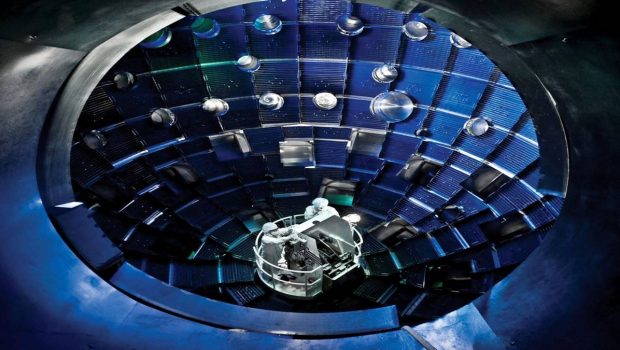Breakthrough in nuclear fusion technology to open a new source of clean energy
Recently, the National Ignition Facility (NIF), a US laboratory, announced that it had accomplished a fusion reaction and got a “net energy gain,” meaning it managed to get more energy than the energy used to initiate a fusion reaction. This is the first time ever in a laboratory where researchers succeeded in generating more energy from fusion reactions than they used to start the process. A small quantity of fusion fuel can generate so much energy that it can run a power plant for years with no carbon dioxide emissions.
This marks a new chapter in the world of nuclear technology in generating clean energy using nuclear fusion.
The NIF is a $3.5 billion laser complex at Lawrence Livermore National Laboratory in California. The output energy it claims to have achieved is 3.15 MJ compared to the input energy of 2.05 MJ. This experiment was conducted by NIF through a process called “thermonuclear inertial fusion” that costs around $3.5 billion.
The breakthrough technology
The technology is based on the fundamentals that power the sun. More so it can produce much more energy than current nuclear fission technology which is prevalent worldwide.
Researchers at NIF initiated this experiment by putting two isotopes of Hydrogen, Deuterium (D) and Tritium (T), in a tiny capsule at a scaled wheat grain size. Then, they projected a high-intensity light beam from 192 lasers. As a result, the electrons come out from their parent atom of the two isotopes, and along with their nuclei, they floated in another state of matter called plasma, which is the fourth state of matter like solid, liquid and gas. While they are in the plasma state, which is a soup of positive (ions) and negatively charged particles (electrons), the bombarding of light continues, resulting in the combination of nuclei. When two nuclei combine or fuse, they release tremendous energy, which is the basis of nuclear fusion.
How does fusion work?
The complexity of nuclear technology is mostly about the atomic breakdown in a controlled environment. What does it entail?
Daya Shankar, Chair Professor-Alok Sinha Professor of Mechanical Engineering, at Penn State University explains the complex process and the impact it will have on the critical need for alternative energy.
“An atom consists of a nucleus and electrons surrounding it—the nucleus consists of positively charged protons and neutrons, which are electrically unchanged. The electrons are present around the nucleus in multiple rings like the Sun and the planets,” he explains.
This is the fundamental approach that scientists have been working on. But why did it take almost half a century to achieve the result?
Shankar highlights the enormous challenges in the experiment. He has worked in Generation IV reactor technology and his doctoral work was on Supercritical Water-cooled Reactors at IIT Guwahati.
He elaborates: “So, now the point is that if we want to fuse these two nuclei, we need to provide more energy to overcome their repulsive forces. A moment came known as the ‘Coloumb Barrier’, after which the attractive power overtakes the repulsive power, and precisely at this point, two nuclei will fuse into each other. But this is not a simple task.
“Hence, to fuse two nuclei, we must overcome one obstacle – the Coloumb Barrier. However, to overcome this obstacle, a tremendous amount of energy is required, which produces a temperature of 100 million Kelvin, six times the Sun’s core temperature.
The fusion experiment
To begin the fusion experiment two approaches are mainly used. These two different methods differ in how energy is supplied to initiate the fusion. In a recent investigation at the Lawrence Livermore facility, scientists used a high-intensity laser beam to start the fusion reaction, also called “thermonuclear inertial fusion”. Another way to start this experiment is by using a strong magnetic field.
International Thermonuclear Experimental Reactor (ITER) is the largest fusion energy experiment facility in the world. It is under construction in France and is being built in collaboration with 35 nations. India is also one of the partners in this project.
Clean energy
Such an experiment will result in cleaner energy. According to researchers, fusion energy will provide clean, safe electricity without greenhouse gas emissions.
“In this way, it is a terrific and commendable step in the path of new carbon-free energy generation for the future,” Shankar highlights the importance of the fusion breakthrough.
“Such possibilities may bring revolution in our approach to addressing the energy crisis, and also address the severe challenges of carbon-emitting energy,” says Shankar.
As an active member of the ITER Project, India joined this group in 2005. The Institute of Plasma Research, Ahmedabad, is the lead institute for this project from India. India has conducted several R&D experiments and manufactured several components for this mega project.
According to the timeline reported, the ITER project will be ready for commercial demonstration by 2040, and for daily uses, it will take another decade. Therefore, it is currently difficult for any of these technologies, like thermonuclear inertial fusion to convince us of the safe and reliable flow of energy for daily activities. Nevertheless, scientists expect that the first inception will happen through ITER. Ultimately, what matters is the ability to produce an alternative source of energy which is clean energy.
Shankar talks about the challenges that lie ahead, saying “This breakthrough shows that we can harness clean energy in the future, but it requires much more innovation and exploration to utilise this technology commercially.”
How soon will it result in industrial applications? He is cautious about the timeline. He predicts: “With the advancement of technologies globally, it still may take 30-40 years to get this technology for everyday use.”








Gloss